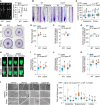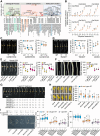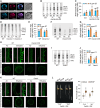CELLULOSE SYNTHASE-LIKE C proteins modulate cell wall establishment during ethylene-mediated root growth inhibition in rice
- PMID: 38943676
- PMCID: PMC11371184
- DOI: 10.1093/plcell/koae195
CELLULOSE SYNTHASE-LIKE C proteins modulate cell wall establishment during ethylene-mediated root growth inhibition in rice
Abstract
The cell wall shapes plant cell morphogenesis and affects the plasticity of organ growth. However, the way in which cell wall establishment is regulated by ethylene remains largely elusive. Here, by analyzing cell wall patterns, cell wall composition and gene expression in rice (Oryza sativa, L.) roots, we found that ethylene induces cell wall thickening and the expression of cell wall synthesis-related genes, including CELLULOSE SYNTHASE-LIKE C1, 2, 7, 9, 10 (OsCSLC1, 2, 7, 9, 10) and CELLULOSE SYNTHASE A3, 4, 7, 9 (OsCESA3, 4, 7, 9). Overexpression and mutant analyses revealed that OsCSLC2 and its homologs function in ethylene-mediated induction of xyloglucan biosynthesis mainly in the cell wall of root epidermal cells. Moreover, OsCESA-catalyzed cellulose deposition in the cell wall was enhanced by ethylene. OsCSLC-mediated xyloglucan biosynthesis likely plays an important role in restricting cell wall extension and cell elongation during the ethylene response in rice roots. Genetically, OsCSLC2 acts downstream of ETHYLENE-INSENSITIVE3-LIKE1 (OsEIL1)-mediated ethylene signaling, and OsCSLC1, 2, 7, 9 are directly activated by OsEIL1. Furthermore, the auxin signaling pathway is synergistically involved in these regulatory processes. These findings link plant hormone signaling with cell wall establishment, broadening our understanding of root growth plasticity in rice and other crops.
© The Author(s) 2024. Published by Oxford University Press on behalf of American Society of Plant Biologists.
Conflict of interest statement
Conflict of interest statement. Authors declare no competing interests.
Figures






Similar articles
-
The activation of OsEIL1 on YUC8 transcription and auxin biosynthesis is required for ethylene-inhibited root elongation in rice early seedling development.PLoS Genet. 2017 Aug 22;13(8):e1006955. doi: 10.1371/journal.pgen.1006955. eCollection 2017 Aug. PLoS Genet. 2017. PMID: 28829777 Free PMC article.
-
MAOHUZI6/ETHYLENE INSENSITIVE3-LIKE1 and ETHYLENE INSENSITIVE3-LIKE2 Regulate Ethylene Response of Roots and Coleoptiles and Negatively Affect Salt Tolerance in Rice.Plant Physiol. 2015 Sep;169(1):148-65. doi: 10.1104/pp.15.00353. Epub 2015 May 20. Plant Physiol. 2015. PMID: 25995326 Free PMC article.
-
Rice EIL1 interacts with OsIAAs to regulate auxin biosynthesis mediated by the tryptophan aminotransferase MHZ10/OsTAR2 during root ethylene responses.Plant Cell. 2022 Oct 27;34(11):4366-4387. doi: 10.1093/plcell/koac250. Plant Cell. 2022. PMID: 35972379 Free PMC article.
-
Cracking the elusive alignment hypothesis: the microtubule-cellulose synthase nexus unraveled.Trends Plant Sci. 2012 Nov;17(11):666-74. doi: 10.1016/j.tplants.2012.06.003. Epub 2012 Jul 9. Trends Plant Sci. 2012. PMID: 22784824 Free PMC article. Review.
-
Carbohydrate-active enzymes involved in rice cell wall metabolism.J Exp Bot. 2024 Oct 30;75(20):6206-6227. doi: 10.1093/jxb/erae295. J Exp Bot. 2024. PMID: 38980746 Review.
Cited by
-
Genome-Wide Analysis of CSL Family Genes Involved in Petiole Elongation, Floral Petalization, and Response to Salinity Stress in Nelumbo nucifera.Int J Mol Sci. 2024 Nov 22;25(23):12531. doi: 10.3390/ijms252312531. Int J Mol Sci. 2024. PMID: 39684243 Free PMC article.
-
Phosphoproteomic insights into the regulation of root length in rice (Oryza sativa L. cv. KDML 105): uncovering key events and pathways involving phosphorylated proteins.PeerJ. 2025 Jul 4;13:e19361. doi: 10.7717/peerj.19361. eCollection 2025. PeerJ. 2025. PMID: 40625925 Free PMC article.
-
Mechanosensing antagonizes ethylene signaling to promote root gravitropism in rice.Nat Commun. 2025 Apr 19;16(1):3712. doi: 10.1038/s41467-025-59047-z. Nat Commun. 2025. PMID: 40251159 Free PMC article.
-
Cell Wall-Based Machine Learning Models to Predict Plant Growth Using Onion Epidermis.Int J Mol Sci. 2025 Mar 24;26(7):2946. doi: 10.3390/ijms26072946. Int J Mol Sci. 2025. PMID: 40243585 Free PMC article.
References
-
- Bian H, Xie Y, Guo F, Han N, Ma S, Zeng Z, Wang J, Yang Y, Zhu M. Distinctive expression patterns and roles of the miRNA393/TIR1 homolog module in regulating flag leaf inclination and primary and crown root growth in rice (Oryza sativa). New Phytol. 2012:196(1):149–161. 10.1111/j.1469-8137.2012.04248.x - DOI - PubMed
MeSH terms
Substances
Grants and funding
LinkOut - more resources
Full Text Sources

